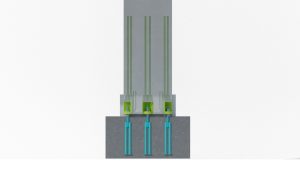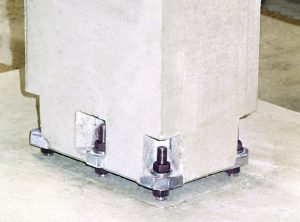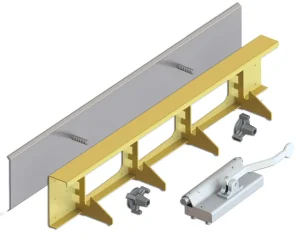14 Exploring the Barriers and Enablers of Using Precast Structural Elements in Residential Construction
Omid Keivanloo
Rationale for Studying the Case
Motivation for the Problem
Although prefabrication is widely recognized for its potential to enhance construction efficiency and quality, its application in concrete structures within the mid-rise residential sector remains limited. This case study investigates why precast structural elements are often viewed as impractical and examines which industry tools or trends might address these challenges.
The study is guided by the following questions:
a. What are the main limitations and barriers in using precast elements in the residential sector?
b. Which emerging industry trends or tools could help resolve these challenges, and in what way?
Precast elements offer the potential for standardization and faster construction timelines. However, unlike wood (e.g., pre-cut or mass timber) or steel (e.g., PEMBs and modular framing), concrete has not widely adopted prefabrication. This disparity is notable, given concrete’s dominant role in urban construction and its potential environmental impact if poorly executed or prematurely demolished.
Purpose and Focus
The purpose of this study is to analyze the barriers, challenges, and enabling factors for incorporating precast structural elements into residential construction. It focuses on key decision-making factors and seeks practical strategies to improve the feasibility and affordability of precast solutions for developers.
Facts Related to the Case
Concrete is globally accepted for multi-story structural frames due to its strength, availability, and versatility, especially in dense urban environments. Its prevalent use in cast-in-place (CIP) form is attributed to its design flexibility. However, this method presents several difficulties:
- Complex formwork requirements
- Prolonged curing times and complicated on-site scheduling
- Dependency on weather and labor conditions
- Frequent rework due to low construction precision
- Inability to achieve economies of scale
Columns are among the most cost-intensive CIP elements, requiring significant formwork, precise alignment, and sequencing. Delays in column construction can directly impact floor cycles and overall project timelines.[1] This example demonstrates how even repetitive elements like posts can become complicated and costly when executed on-site.
Recent mass housing projects using cast-in-place methods, despite employing industrial formwork systems, have often resulted in poor construction quality, inflexible layouts due to the high upfront cost of formwork, and inadequate lifecycle planning. These issues increase the environmental impact of concrete by reducing the lifespan of residential units. Consequently, the need for predesigned, integrated, and adaptable structural systems becomes evident.
Although prefabrication theoretically addresses these problems, past implementations raise concerns. Panelized precast systems are not a novel concept[1] and for example the Plattenbau model of the mid-20th century demonstrated benefits like speed and standardization but failed in terms of long-term livability and flexibility. Also today, while modern precast approaches are more prevalent in commercial buildings and hotels, they are still often considered more expensive than CIP construction.[1]
Description of the Data Collected
Sources of Data
This qualitative case study draws upon the following sources:
- A semi-structured interview with an industry expert in April 2025
- A conversation with an academic faculty member regarding prefabrication viability
- Review products from BT Innovation, Peikko, and HALFEN companies, offering insights into technical innovations enabling precast construction
Key Considerations Identified
Motivations and Predictions “If you design it to come apart, you can move it, reuse it. That’s a solid sustainability argument.”[1]
- Design for Deconstruction: Dry connection systems facilitate not only speed but also disassembly and reuse, contributing to sustainability.
- Industry Parallel: Analogy of construction’s evolution to apparel industry, shifting from bespoke tailoring to fast, sustainable fashion. (Mentioned by the faculty member)
Cost Factors “You only get lean by the third time you do it.”[1]
- Initial Setup: High initial costs stem from coordination, prototyping, and fabrication challenges.
- Repetition Limitations: Single residential projects lack repetition, which impedes cost efficiency.
- Pilot Investment: A significant upfront investment is needed to trial and refine new precast systems.
Process and Implementation Issues “Modeling isn’t the solution; it’s how and when you model that matters.”[1]
- Modeling Practices: BIM tools are widely used, but without appropriate LOD and sequencing, their benefits diminish.
- Labor and Site Constraints: Regional labor availability and logistical conditions affect cost-efficiency.
- Risk Aversion: Developers often avoid innovation due to perceived risks and past failures.
Innovations and Enablers
- Digital Tool Adoption: VDC is advancing through digital platforms and hardware such as CNC routers, 3D printers, and laser cutters.
Below products are all made possible by above mentioned digital tools:- Peikko’s BOLDA®[2]
- HALFEN’s HCC[4]
- BT Innovation’s BT-Spannschloss® and Multiform magnetic formwork systems[3]


Discussion of the Patterns / Theories
When appropriately implemented, prefabrication holds the potential to transform the residential construction sector in the same way that fast and sustainable fashion has reshaped the apparel industry; by integrating affordability, quality, speed, safety, and sustainability.
Early implementations, such as the Plattenbau model, failed due to poor design integration, limited layout flexibility, and the absence of adequate tools. Collaboration, sequencing, coordination and the level of details in design are essential and critical considerations in precast construction[1] and these were largely limited by the absence of digital technologies at the time. These shortcomings undermined the long-term viability of early prefabrication systems.
In contrast, recent applications supported by more advanced tools have allowed for greater design flexibility and adaptability, particularly in commercial and hotel developments, where there is a high potential for iterations and scalability. Nonetheless, even in these projects, precast methods often remain more costly than cast-in-place construction due to the high initial investment required.[1]
As a result, the adoption of precast systems in residential buildings has become constrained by a three-way trade-off among affordability, scale, and design flexibility. In mid-rise housing, where achieving repetition at scale is limited and flexible and livable design is an important factor to avoid past failures, cost remains as the only variable of the trade-off. However, if adopting precast resulted in less affordable outcome, it may not offer a viable solution.
To overcome this challenge, innovation is essential. As digital design tools and fabrication technologies (e.g. CNC routers, 3D printers, and laser cutters) become more accessible, and as professionals become more skilled in their application, there is increasing potential for integrative and iterative solutions. These approaches support pilot programs that allow for experimentation and refinement. Rather than relying on the repetition of entire units, such strategies enable scalability through modular components of the structure, preserving final product design flexibility while enhancing affordability and feasibility—all at once.
It is notable that the mentioned companies above like Peikko and Halfen, are trying to enable the use of modular precast structural elements by their innovative technologies for connecting such pieces, e.g. BOLDA®[2] and HCC[4] column shoes and BT Innovation approaches of design and production of formwork, e.g. Multiform[3] systems aim to make formwork systems for such pieces more flexible in dimension while keep the initial cost low, ultimately support the design flexibility at an affordable cost.

Connection to the Larger Schemes
This case study contributes to broader discussions about the future of industrialized, cost-sensitive housing. It reflects several key global trends and industry transformations:
- Increasing potential of AI and generative design to support modular and prefabricated construction
- Enhanced precision and efficiency through digital technologies
- Emerging need for new workflows and team roles
- Streamlined supply chains supporting responsive construction
- Opportunities to deliver affordable, high-quality housing at scale
- Improved environmental outcomes from reduced material waste and smarter design
- Growing importance of supportive codes, regulations, and financial incentives
- Deeper understanding of reusability and lifecycle performance
- Recognition of hidden costs in CIP systems, including delays and rework
In sum, the shift toward prefabricated systems represents a pivotal opportunity, requiring innovation, regulation, and cultural change, to reshape how the built environment is designed and delivered.
References
[1] Industry expert, Interview, Apr. 2025.
[2] Peikko Group, “BOLDA® Column Connection System,” 2024. [Online]. Available: https://www.peikko.com/products/product/bolda/
[3] BT Innovation, “Product Systems and Formwork Technologies,” 2024. [Online]. Available:
https://www.bt-innovation.de/en/products/
[4] HALFEN GmbH, “Precast Reinforcement and Anchoring Systems,” 2024. [Online]. Available: https://www.halfen.com/en_DE/company/about-halfen

